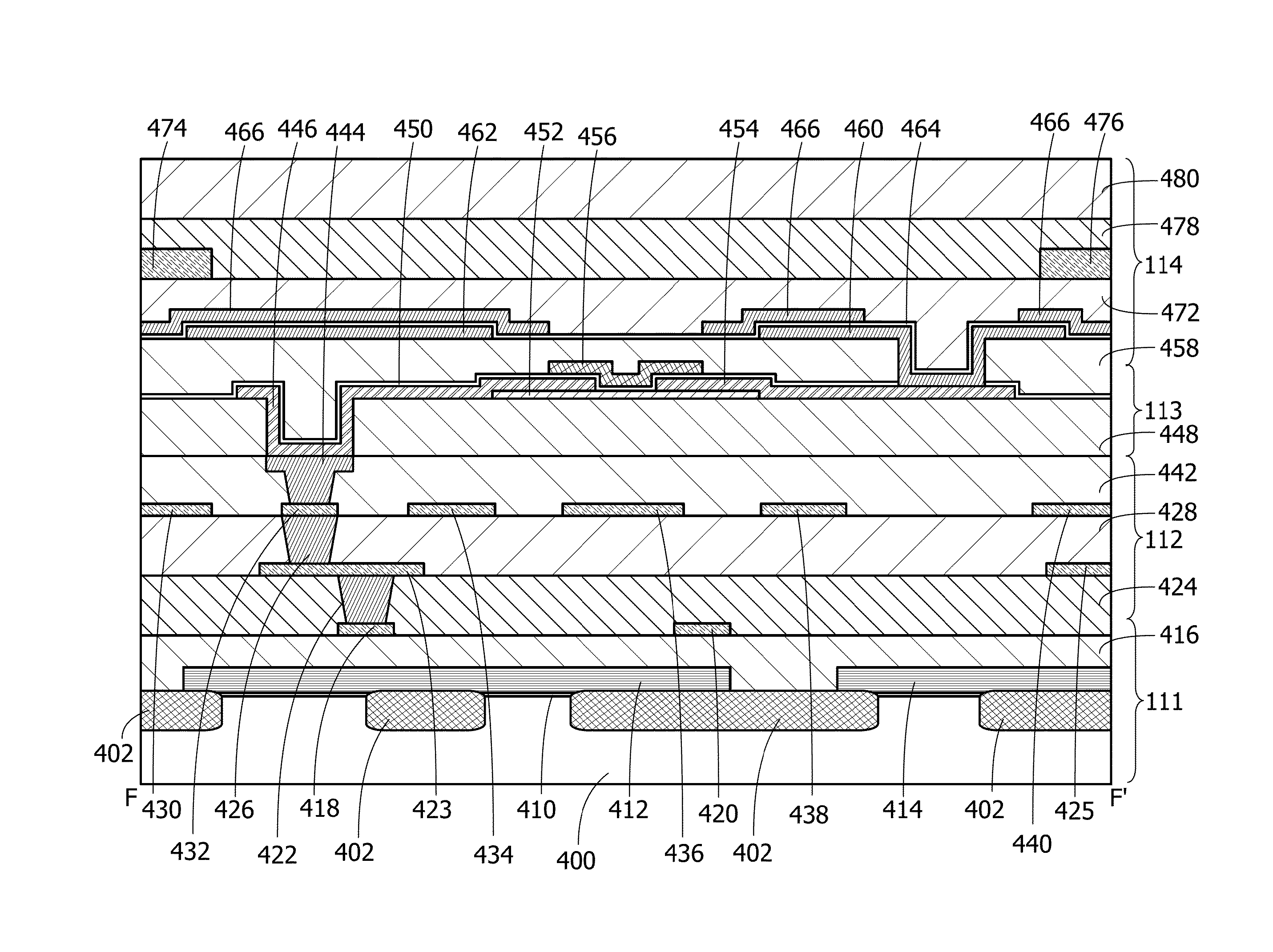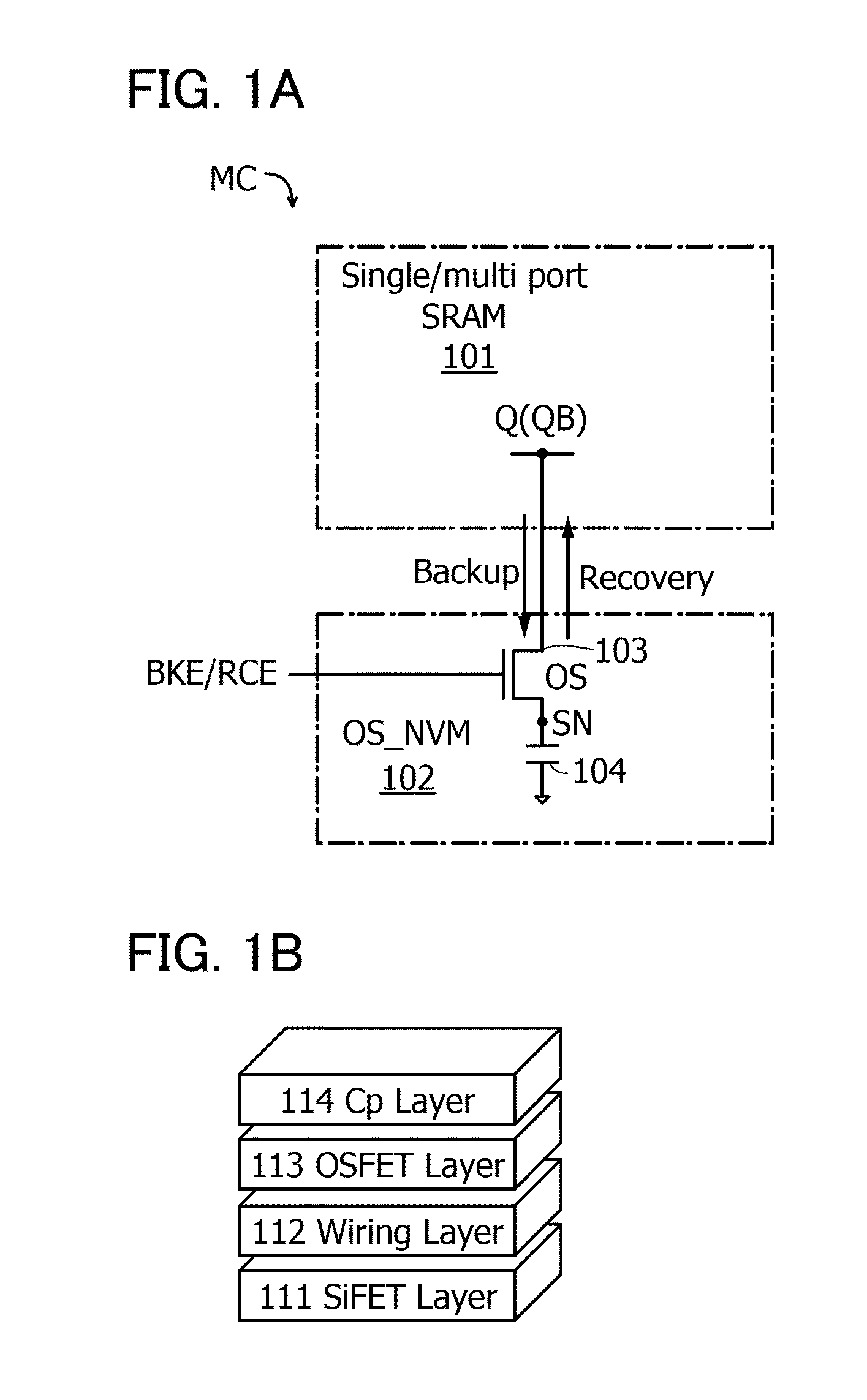Semiconductor device, electronic component, and electronic device
a technology of semiconductor devices and components, applied in semiconductor devices, digital storage, instruments, etc., can solve problems such as data loss, and achieve the effect of increasing layout area and speed
- Summary
- Abstract
- Description
- Claims
- Application Information
AI Technical Summary
Benefits of technology
Problems solved by technology
Method used
Image
Examples
embodiment 1
[0058]In this embodiment, circuit diagrams, top views, cross-sectional views, and a timing chart of a semiconductor device are described.
[0059]In this specification and the like, a semiconductor device means all devices that can function by utilizing semiconductor characteristics. The term “semiconductor device” refers to a memory such as a cache formed using semiconductor elements, e.g., transistors, peripheral circuits for controlling the memory, a CPU which inputs / outputs a signal to / from the memory and the peripheral circuits, a power supply voltage supplying circuit, a power management unit, and the entire system including the circuits.
[0060]As one embodiment of the semiconductor device, a configuration of a memory cell MC is described.
[0061]FIG. 1A is an outline circuit diagram of the memory cell MC.
[0062]The memory cell MC illustrated in FIG. 1A includes an SRAM101 and a data memory portion 102. The data memory portion 102 includes a transistor 103 and a capacitor 104.
[0063]T...
embodiment 2
[0151]In this embodiment, an example of the operation different from that of the memory cell MC described in the above embodiment is described.
[0152]In this embodiment, operation of the memory cell MC illustrated in FIG. 12 is described. The memory cell MC illustrated in FIG. 12 includes the multiport SRAM 101 in FIG. 7A and the data memory portion 102 in FIG. 11B for static data recovery.
[0153]Note that in FIG. 12, nodes holding charge corresponding to data in the data memory portion 102 are denoted by SN3 and SN4.
[0154]Note that a power supply voltage supplied to the inverters INV7 and INV8 in FIG. 12 may be the same as in the SRAM 101 as illustrated in FIG. 25A, or may be a power supply voltage (VDM2 / VSS) which is different from that in the SRAM 101 as illustrated in FIG. 25B.
[0155]FIGS. 13A and 13B and FIG. 14 are timing charts different from that of the operation of the memory cell MC illustrated in FIG. 12. FIGS. 13A and 13B illustrate operation of the power supply potential l...
embodiment 3
[0169]In this embodiment, configurations of block diagrams of a cache including the memory cell MC illustrated in FIGS. 1A and 1B and circuits accessing the cache are described.
[0170]A semiconductor device 30 includes a cache 300 (denoted by Cache), a power supply voltage supplying circuit 330 (denoted by Supply Voltage), a power management unit 340 (denoted by PMU), a CPU 350, an input / output interface 360 (denoted by I / O UF), and a bus interface 370 (denoted by Bus UF), as shown in FIG. 16.
[0171]The power management unit 340 has a function of performing power gating of the circuits included in the cache 300. The power management unit 340 outputs a power gating control signal (PGCS). Thus, the power consumption of the semiconductor device 30 can be reduced.
[0172]The power management unit 340 performs power gating in accordance with a sleeping signal (denoted by Sleeping) from the CPU 350, a signal from external hardware through the input / output interface 360, or a state of the bus ...
PUM
 Login to View More
Login to View More Abstract
Description
Claims
Application Information
 Login to View More
Login to View More - R&D
- Intellectual Property
- Life Sciences
- Materials
- Tech Scout
- Unparalleled Data Quality
- Higher Quality Content
- 60% Fewer Hallucinations
Browse by: Latest US Patents, China's latest patents, Technical Efficacy Thesaurus, Application Domain, Technology Topic, Popular Technical Reports.
© 2025 PatSnap. All rights reserved.Legal|Privacy policy|Modern Slavery Act Transparency Statement|Sitemap|About US| Contact US: help@patsnap.com



